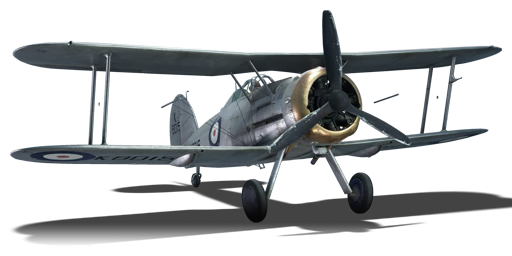

Aviation
Tuck's Gladiator Mk II
I
Rank
AB
1.3
RB
1.0
SB
1.3
Battle rating
Great Britain
Research country
Fighter
Main role
250

Purchase

Premium vehicle
Status
General information
Flight performance
Max speed
at 4,420 m
414387429399 km/h
Rate of Climb
15.71318.813 m/s
Turn time
1617.715.316.7 s
Max altitude
10,211 m
Takeoff Run
231 m
Landing
flaps
flaps
Take-off
flaps
flaps
Combat
flaps
flaps
Air
brake
brake
Gear
control
control
General characteristics
Crew
1 person
Engine
Length
8.4 m
Wingspan
12.5 m
Wing Loading
73 kg/m²
Weight:
Base weight
1.841.91.81.89 t
Fuel in main tanks
0.28 t (1h 25m)
Limits:
Max Speed Limit (IAS)
560 km/h
Mach Number Limit
0.75 M
G limit
≈ -6/12 G
Flap Speed Limit (IAS)
L / T
320 / 469 km/h
Offensive armament
4 × 7.7 mm Browning machine gun
Ammunition
2,000 rounds
Fire rate
1,000 shots/min
One-second Burst Mass
0.17 kg
| Belt | Belt filling | Armor penetration (mm) at a distance: | |||||
|---|---|---|---|---|---|---|---|
| 10 m | 100 m | 500 m | 1000 m | 1500 m | 2000 m | ||
| T/AP/AP-I/Ball/Ball/I | 13 | 12 | 7 | 3 | 2 | 0 | |
| T/AP/AP-I/AP-I/I | 13 | 12 | 7 | 3 | 2 | 0 | |
| IT/AP-I | 13 | 12 | 7 | 3 | 2 | 0 | |
| AP-I/AP-I/I | 13 | 12 | 7 | 3 | 2 | 0 | |
Economy
Repair cost
AB
323 

RB
139 

SB
136 

Crew training
150 

Experts
1,000 

Aces
20 

Research Aces
145,000 

Reward multiplier
AB / RB / SB
 2 x (15 / 25 / 70) %
2 x (15 / 25 / 70) % 
 2 x 75 %
2 x 75 % 
Total cost of modifications
5,020 

505 

Flight performance | |
|---|---|
Survivability |
|---|
Weaponry |
|---|
Rating by players
You must play more than 3 battles for the last week and more than 10 battles in a vehicle to rate it.
Like:
17
Flight performance:
Not enough ratings
Survivability:
Not enough ratings
Aerial combat:
Not enough ratings
Ground attack:
Not enough ratings
Balance:
Not enough ratings
Tips & Tricks
This space is currently empty
Do you know any interesting vehicle features?
Loading...
No articles about this vehicle yet
Become the first author and get rewards!
Write a guide, tell about interesting historical facts, make a tutorial or simply an interesting post.
No more content